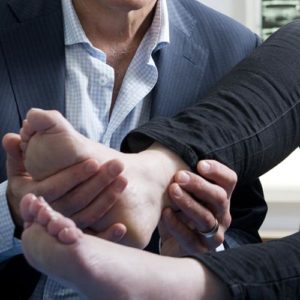

Ankle arthroscopy is most often performed to remove scar tissue and inflammation or to remove small detachments of bone and cartilage.
Recent advances have permitted surgical procedures to be performed inside joints without opening the joints by traditional methods. Using a fibre-optic device called an arthroscope, orthopaedic surgeons are able to inspect the inside of a joint by direct vision. This can be done to make a diagnosis or carry out surgical procedures.

The arthroscope is inserted through a small hole on the front of the ankle whilst fine instruments are inserted through another one or two holes. Video equipment is used so your doctor can view the entire procedure on a TV monitor in the operating theatre. The ankle arthroscopy usually takes between 30 and 45 minutes.
Arthroscopy has distinct advantages for the patient including reduced scarring, less disruption to surrounding soft tissue structures, shorter hospital stay and faster recovery. Some arthroscopic procedures can be done under spinal or regional anaesthesia, therefore eliminating the need for a general anaesthetic.
Your specialist will be able to advise whether arthroscopic surgery is relevant to your particular joint problem or injury.
Post-operative infection is very uncommon with arthroscopy, but if it does occur, it needs to be treated promptly to avoid serious ill effects.
If you experience increased swelling, pain, persistent temperature, or purulent discharge, please call your doctor or see your local medical officer immediately.
Patients are routinely admitted to hospital on the same day as the procedure. In most cases if the patent is fit to leave the hospital later the same day. Sometimes, depending on the type of surgery and the needs of the patient, an overnight stay is recommended.
Following the surgery you will just have a crepe bandage around the ankle. For the first few days, you will be required to use crutches after which you will be allowed to weight bear as tolerated.
If more extensive surgery is carried out you will be instructed to remain on crutches for 10 – 14 days. For the first few days at home it is important to keep your foot elevated above the level of the heart as much as possible. This will greatly reduce the amount of pain and swelling. In addition, applying a cold pack to the area during the first 48 hours will decrease any discomfort. It is important that the dressings remain undisturbed until the first visit with your doctor. This will require the use of plastic bags to keep the dressing from becoming wet during bathing.
The first post-operative visit is scheduled for 10 – 14 days following surgery. The wounds are checked and the stitches removed. Another review is then scheduled usually for 6 weeks post surgery. It usually takes 2-3 months for the majority of swelling and discomfort to resolve.
It usually takes 8 – 12 weeks before the level of function is better than before surgery. Each patient’s recovery will be different. Your Doctor will discuss the best time for you to return to work and return to sport.
Book an appointment with our orthopaedic specialists
Book an appointment